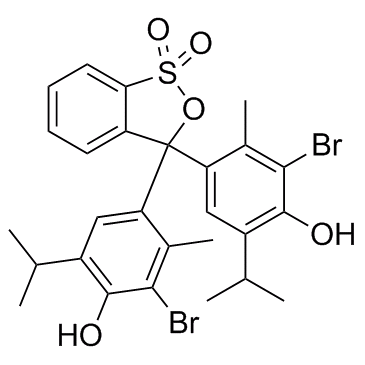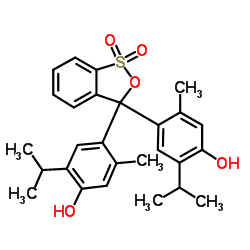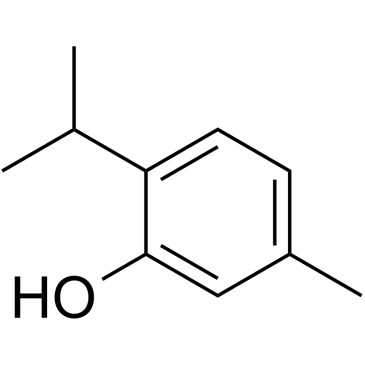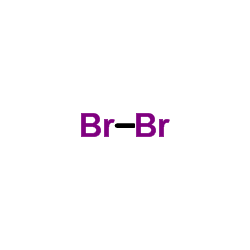Bromothymol blue

Bromothymol blue structure
|
Common Name | Bromothymol blue | ||
|---|---|---|---|---|
| CAS Number | 76-59-5 | Molecular Weight | 624.381 | |
| Density | 1.5±0.1 g/cm3 | Boiling Point | 614.3±55.0 °C at 760 mmHg | |
| Molecular Formula | C27H28Br2O5S | Melting Point | 204 °C | |
| MSDS | Chinese USA | Flash Point | 325.3±31.5 °C | |
| Symbol |

GHS02 |
Signal Word | Warning | |
Use of Bromothymol blueBromothymol Blue is a pH indicator. |
| Name | bromothymol blue |
|---|---|
| Synonym | More Synonyms |
| Description | Bromothymol Blue is a pH indicator. |
|---|---|
| Related Catalog | |
| In Vitro | A first characterization and comparison is done by developing an easy and direct measurement method based on a pH indicator system using Bromothymol Blue (BTB) as the indicator and potassium phosphate as the buffer. A pH-shift assay is developed on the basis of BTB as the pH indicator and potassium phosphate as the buffer component[1]. Three pH indicators are tested for the direct determination of 2- 2-keto-L-gulonic acid (2-KLG) production on a plate. The results show that Bromothymol Blue is superior to the other two indicators in terms of the obvious color change and a suitable pH range (blue to yellow at pH 6.5-7.5). Upon the addition of a Bromothymol Blue solution (0.1%, w/v) to an agar plate, zones surrounding colonies of K. vulgare 07 mutants change their color from blue to yellow because K. vulgare 07 mutants release 2-KLG on agar plates, thereby acidifying surrounding areas around colonies[2]. |
| Kinase Assay | For all three enzymes, an expression in the 96-deep well scale is performed. Therefore, electrocompetent E. coli ArcticExpress(DE3) cells are transformed with the corresponding plasmid. Single clones are picked using the CP7200 Colony Picker and transferred to 96-deep well plates filled with 1.2 mL autoinduction media by a MicroFlo Select dispenser. After incubation (36 h, 37°C at 1,000 rpm), further processing is done manually. First, 100 μL of cell culture is transferred into a 96-well plate (U-shaped bottom) and harvested by centrifugation (4,570 rpm, 10 min at RT) while the supernatant is discarded. The frozen pellets (1 h at -20°C) are thawed at room temperature for one hour to improve cell lysis. Lysis is continued by the addition of 30 μL lysis buffer (3 h, 1,000 rpm, 37°C) containing 2 mM KPi, pH 7.0, 2 mM MgCl2, 10 μg/mL DNaseI, 100 μg/mL lysozyme. Next, 120 μL buffer (2 mM KPi, pH 7.0) is added followed by centrifugation (3,000 rpm, 15 min at RT). For the photometric measurement, 20 μL of the crude extract is transferred to a 96-well plate (F-shaped bottom) and the reaction is started by adding 180 μL master mix to give a final volume of 200 μL (2.5 mM KPi, pH 7.0, 2 mM MgCl2, 25 μg/mL BTB and 5 mM keto-deoxy-D-glucarate). The measurements are carried out for 60 min at 2-min intervals. Depending on the enzyme, different time windows are used for the activity calculation[1]. |
| References |
| Density | 1.5±0.1 g/cm3 |
|---|---|
| Boiling Point | 614.3±55.0 °C at 760 mmHg |
| Melting Point | 204 °C |
| Molecular Formula | C27H28Br2O5S |
| Molecular Weight | 624.381 |
| Flash Point | 325.3±31.5 °C |
| Exact Mass | 622.002380 |
| PSA | 92.21000 |
| LogP | 8.60 |
| Vapour Pressure | 0.0±1.8 mmHg at 25°C |
| Index of Refraction | 1.634 |
| InChIKey | NUHCTOLBWMJMLX-UHFFFAOYSA-N |
| SMILES | Cc1c(C2(c3cc(C(C)C)c(O)c(Br)c3C)OS(=O)(=O)c3ccccc32)cc(C(C)C)c(O)c1Br |
| Storage condition | Store at RT. |
| Stability | Stable. Incompatible with strong oxidizing agents. |
| Water Solubility | slightly soluble |
CHEMICAL IDENTIFICATION
|
| Symbol |

GHS02 |
|---|---|
| Signal Word | Warning |
| Hazard Statements | H226 |
| Personal Protective Equipment | Eyeshields;Gloves;type N95 (US);type P1 (EN143) respirator filter |
| Hazard Codes | Xn |
| Risk Phrases | R10 |
| Safety Phrases | S24/25-S39-S26 |
| RIDADR | NONH for all modes of transport |
| RTECS | SJ450000 |
| Packaging Group | III |
| HS Code | 29349990 |
|
~% 
Bromothymol blue CAS#:76-59-5 |
| Literature: J. Washington Acad., vol. 6, p. 482 Chem. Zentralbl., , vol. 87, # II p. 1068 J. Washington Acad., vol. 5, p. 616 Chem. Zentralbl., , vol. 87, # I p. 175 |
|
~% 
Bromothymol blue CAS#:76-59-5 |
| Literature: J. Washington Acad., vol. 6, p. 482 Chem. Zentralbl., , vol. 87, # II p. 1068 |
|
~% 
Bromothymol blue CAS#:76-59-5 |
| Literature: J. Washington Acad., vol. 6, p. 482 Chem. Zentralbl., , vol. 87, # II p. 1068 J. Washington Acad., vol. 5, p. 616 Chem. Zentralbl., , vol. 87, # I p. 175 |
| Precursor 4 | |
|---|---|
| DownStream 0 | |
| HS Code | 29349990 |
|---|
|
Real-time UV imaging identifies the role of pH in insulin dissolution behavior in hydrogel-based subcutaneous tissue surrogate.
Eur. J. Pharm. Sci. 69 , 26-36, (2015) For parenteral biopharmaceuticals, subcutaneous diffusion and, in the case of solid implants or suspensions, dissolution may govern the clinical profile of the drug product. Insight into the dissoluti... |
|
|
The transcription factor BcLTF1 regulates virulence and light responses in the necrotrophic plant pathogen Botrytis cinerea.
PLoS Genet. 10(1) , e1004040, (2014) Botrytis cinerea is the causal agent of gray mold diseases in a range of dicotyledonous plant species. The fungus can reproduce asexually by forming macroconidia for dispersal and sclerotia for surviv... |
|
|
The VELVET Complex in the Gray Mold Fungus Botrytis cinerea: Impact of BcLAE1 on Differentiation, Secondary Metabolism, and Virulence.
Mol. Plant Microbe Interact. 28 , 659-74, (2015) Botrytis cinerea, the gray mold fungus, is an important plant pathogen. Field populations are characterized by variability with regard to morphology, the mode of reproduction (conidiation or sclerotia... |
| 2-bromo-4-[3-(3-bromo-4-hydroxy-2-methyl-5-propan-2-ylphenyl)-1,1-dioxo-2,1λ<sup>6</sup>-benzoxathiol-3-yl]-3-methyl-6-propan-2-ylphenol |
| Phenol, 4,4'-(3H-2,1-benzoxathiol-3-ylidene)bis[2-bromo-3-methyl-6-(1-methylethyl)-, S,S-dioxide |
| EINECS 200-971-2 |
| a,a-Bis(6-bromo-5-hydroxycarvacryl)-a-hydroxy-o-toluenesulfonic Acid g-Sultone |
| 4,4'-(1,1-dioxido-3H-2,1-benzoxathiole-3,3-diyl)bis[2-bromo-3-methyl-6-(propan-2-yl)phenol] |
| Thymol, 6,6'-(3H-2,1-benzoxathiol-3-ylidene)bis(2-bromo-, S,S-dioxide (8CI) |
| Phenol, 4,4'-(1,1-dioxido-3H-2,1-benzoxathiol-3-ylidene)bis[2-bromo-3-methyl-6-(1-methylethyl)- |
| 4,4'-(3H-2,1-Benzoxathiol-3-ylidene)bis[2-bromo-3-methyl-6-(1-methylethyl)phenol] S,S-Dioxide |
| 3',3''-Dibromothymolsulfonphthalein |
| Bromthymol Blue |
| 4,4'-(1,1-Dioxido-3H-2,1-benzoxathiole-3,3-diyl)bis(2-bromo-6-isopropyl-3-methylphenol) |
| Bromothymol blue |
| MFCD00005872 |





